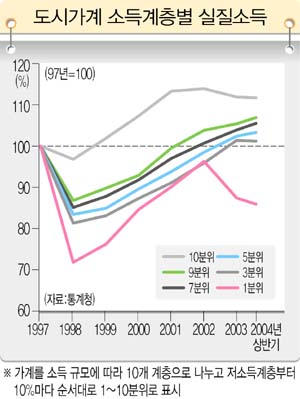there are workers, but where's the working class
| Son Seok-chun, member of Hankyoreh editorial board, writes much more convincingly when creating an argument of his own like in this column in Nodonggwa Segye than when doing just reply commentary mostly to views presented in Chosun, like he mostly seems to be doing in the pages of Ohmynews. The Nodonggwa Segye (Worker and The World) is about the necessity of intellectual development among the workers. For Son, this would mean the development of a more clearly defined working class identity. It is true that historical and political circumstances in South Korea haven't really been favorable (to put it mildly) for a creation of a working class identity, but now that those circumstances have changed, it doesn't necessarily follow that manual workers will start thinking of themselves as "working class" any better. And I just would never dare claim that the intellect of a Korean manual worker is in need of development just for the fact his or her identity as "Korean working class" is not as clear as it should be (considering the person's position towards work and capital, for example). There is also the paradoxical situation that the workers who are best organized, most united, best able to represent and defend their interests as workers are also in a best position to provide their children so that they don't become workers. Hankyoreh has an article series about the problems of growth and redistribution of wealth: the article "You to Towerplus, me to rental room"(*) once again notes the growing disparity between big and small companies. If the pay level in big companies with 500 or more employees is set at 100, the level in middle-sized companies (30-100 employees) was 84.5 and in small companies (10-29 empl) 83.5 in the year 1998. In 2003, the respective wage levels compared to big companies were down to 81 and 78.  (*)Towerplus is the luxury apartment complex in Gangnam, which has become the symbol of conspicuous wealth in Korea. The "rental room" in the title is jjokpang, room that is rented on a daily basis in dorm-like houses mostly in downtown areas. My understanding is that many renters from the "redeveloped" hillside settlements who haven't been able to acquire other housing have ended up in these places. Here Towerplus and jjokpang are of course used to create an image of a severe bipolarization of society. (*)Towerplus is the luxury apartment complex in Gangnam, which has become the symbol of conspicuous wealth in Korea. The "rental room" in the title is jjokpang, room that is rented on a daily basis in dorm-like houses mostly in downtown areas. My understanding is that many renters from the "redeveloped" hillside settlements who haven't been able to acquire other housing have ended up in these places. Here Towerplus and jjokpang are of course used to create an image of a severe bipolarization of society.Further in Hankyoreh: "Worker's life more difficult than during the currency crisis". It may not be correct to define the bottom tenth income stratum as "workers", but according to the recent statistics, the real income (silje sodûk) of the bottom tenth has not recovered to the pre-crisis level of 1997. Categories at del.icio.us/hunjang: stratification ∙ socialcategories ∙ work ∙ |



Comments to note "there are workers, but where's the working class" (Comments to posts older than 14 days are moderated)
Write a Comment